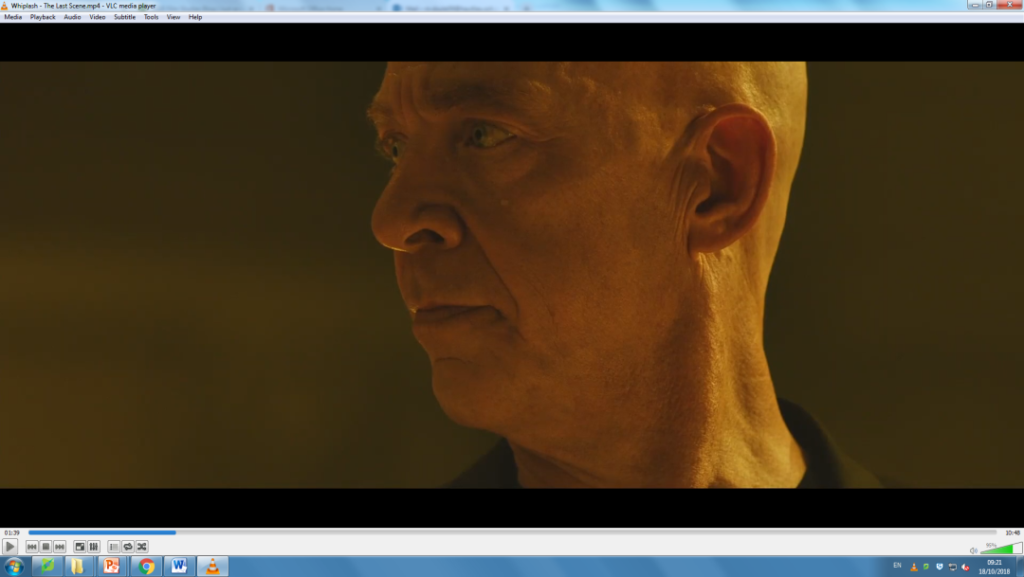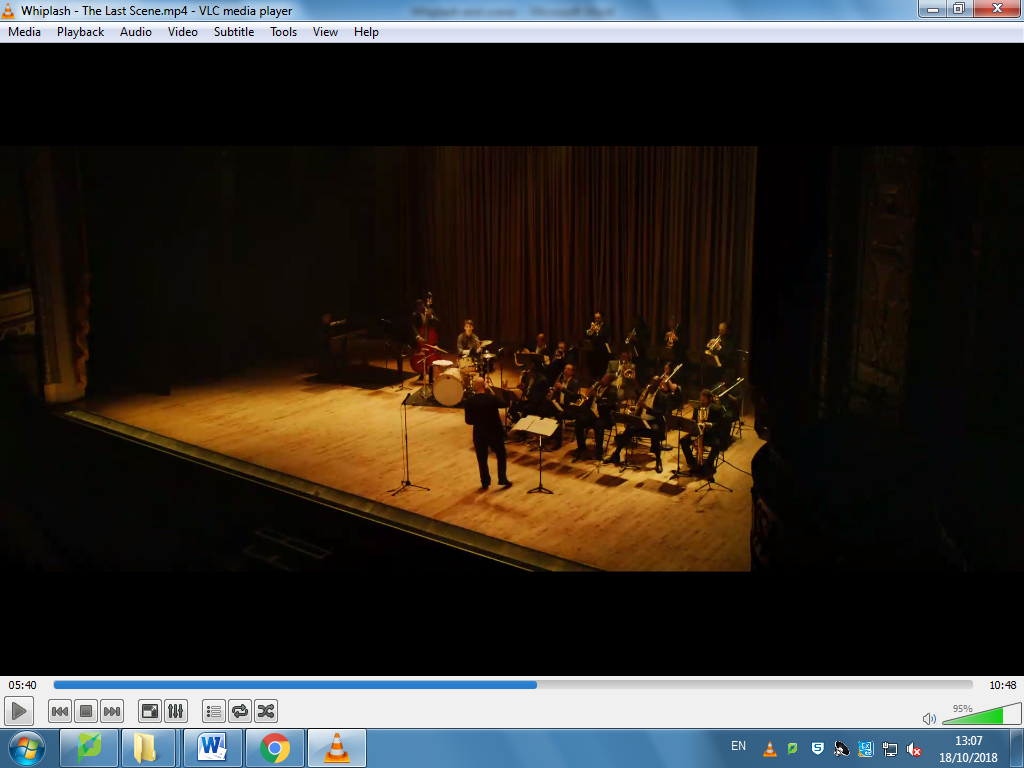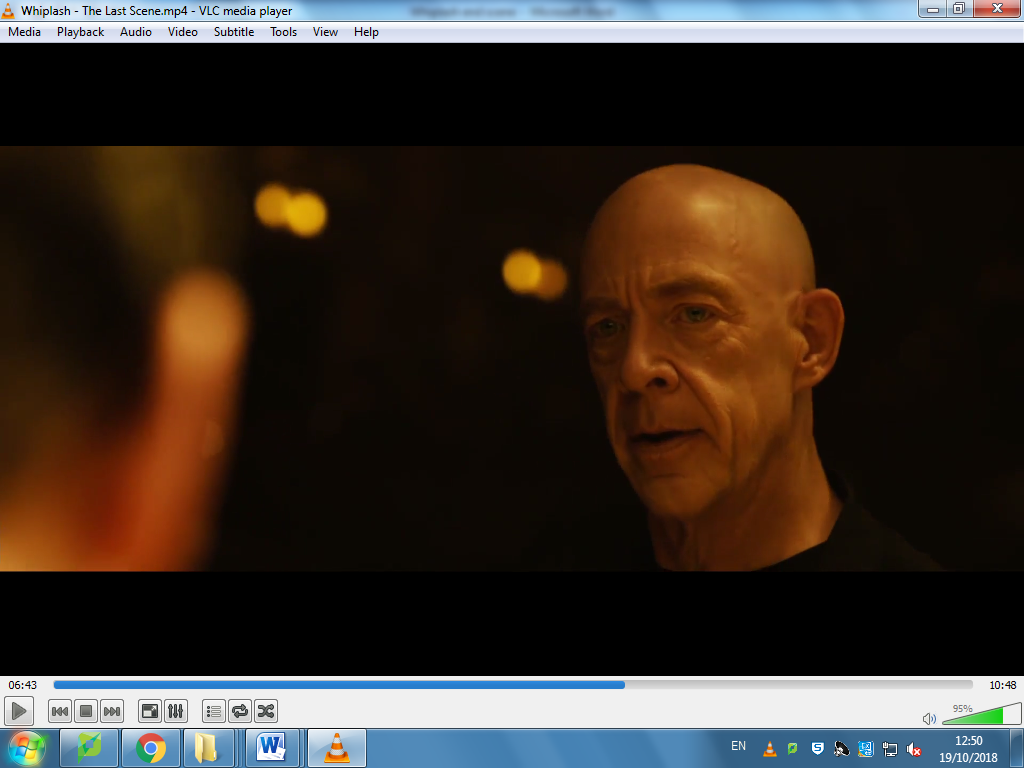The ending scene of Whiplash (2014, by Damien Chazelle) displays a wide varied range of editing techniques to fully immerse the audience within the film and keep them interested for the remaining time. A good editing technique used an eyeline match. This is used to show the intense gaze Fletcher is expressing, the shot later cuts to one of Andrew, showing that it was him who Flethcer was staring at. This is a powerful cut because it shows the real shock and almost awe of Fletcher which contrasts against his prior vile and aggressive characterstics. This contrast does not make us particularly like him, especially after what he put Andrew through; but the slight change in his personality expresses his true passion in coaching and how despite his abusive nature, he does care about Andrew’s success. This cut is significant to the plot because it adds more depth towards Fletcher’s character which helps solidify his importance within the fim. It also expresses his reaction as just as significant as Andrew’s by focusing on him as a parralel to Andrew. This has a profound effect on the audience because it shows the strong and extremely emotive impact Andrew has on Fletcher dspite his aggressive behaviour displayed earlier.

An establishing shot is used very effectively within this shot to unify the band as one. This is an interesting contrast against the prior restricted interaction only between Andrew and Fletcher, with the occaional singling out of band members to aesthetically please the audience. By showing the band as a group, we are reminded that despite Andrew’s success as the obvious protagonist of the film, the band requires unity and teamwork to work cohesively to produce the music. The shot is showed from both a right and left high angle shot, almost verging on birds eye view. I think that this would have a lasting effect on the audience because they are shown the stage as if it was perhaps a filmed musical performance opposed to a fictional film. This works well in ensuring versimilitude because we are shown different angles and aspects of the action to the point where we feel included in what is going on. Another thing to consider is the physical positioning of the band as a group contrasted to their separate closeups prior. This can reflect how Fletcher had set Andrew up, in hopes of humiliating him by having him play different music. At the start, the other musicians are shown only unified together whereas Andrew is only shown alone. But by this point, Andrew has begun to understand what Fletcher has done to him and fights back against it. This fully unifies the band together, which could be why they are positioned together for once rather than seperating into just the band and Andrew who is considered an outsider. This can have a very emotional impact on the audience who symphasize for Andrew

The scene opens with an extremely long close-up shot of Andrew’s face, which reflects the humiliation suffered at the hands of Fletcher. This is held for almost seventeen seconds, which is an awkward, considerably long length of time. This could be done to enforce Andrew’s uncomfortableness on the audience by forcing us to stare at his unamused demeanour for a while. This can be done to make us understand his character even further because; to a certain extent, we are experiencing what he is. This ensures great levels of realism and depth within his character because his issues are that of somewhat relatable which continues to make Andrew a likeable character which cements his protagonist role. I think that this shot would have an intriguing impact on the audience because although nothing happens, tension is built successfully as we are waiting for the moment where the camera finally breaks away from him. The shot is followed up by a dramatically short cut to the audience’s unamused and almost bored reaction at the whole climatic drama. This is done extremely cleverly to avoid giving away too much of Fletcher’s reaction to And rew, saving his later shock but eventual pride for him later on in the ending shot of the scene

An example of the Kuleshov effect is used to portray Andrew’s reaction at the audience’s disapproval about his embarrassment due to Fletcher. The shot begins with a solemn look at his face, which cuts to the audience looking extremely disapproved. This is followed by another cut to the same disappointed look across Andrew’s face. This shows the impact that the audience has on Andrew, indicating his strong passion for performing due to his sadness towards their negative reaction towards him. Most of the film is based around his desperate desire to be the best; this is reinforced in a heart-breaking way for the audience, as his facial expression reflects his true disappointment at Fletcher’s let down. However, this spurs on his desire to be better and come back fighting which impacts the audience who should have grown to appreciate his perfectionist attitude.
One of the most arguably best shots in the scene was the interesting montage of the musicians together. A crab shot is used to establish the musicians each in turn, visually displaying their significance as a united band. This promotes significant message of equality and team-work by individually recognising each musician. By expressing this shot as a montage, we can take our focus away from the deeply emotional scenes from Andrew and Fletcher, and rather instead focus on the other musicians who are shown. This can express the vital messages about equality in an interesting way which doesn’t break the tension because of how fast-paced the montage is. The mix of fast transitions and music helps speed up the atmosphere.

Shot reverses are also frequently used to build tension within the scene. These are used to convey the strong passionate feelings of Andrew and Fletcher by ignoring the disagreements that they had and actually uniting them together with a common passion. Their facial expressions successfully show the audience how passionate they are by switching from Andrew to Fletcher’s reactions. This is to show that despite Fletcher’s negative attitude and behaviour, everything he does is for a reason. The audience can understand this by seeing the clear passion evident in his reaction to Andrew’s drumming. This does not excuse his behaviour but rather lets us understand it, substituting his malevolent behaviour in favour for hard work expressed in the entirely wrong way. This technique is significant because it expresses the importance of emotion within the film by framing both men’s emotions clearly on stage. This contrasts against everything that has happened, suggesting that there is a reason for all of the hardship and despite how tough things get; success can be achieved. As the audience, we are observing the characters reactions and expressions opposed to their actions, implying that Andrew’s success is merely based form his own goals. Although his physical success of drumming is displayed, we are shown both men’s reactions to it; implying that their perception of the events are just as, and if not more important than the end goal. This is shown at the end to suggest that Andrew’s journey was worth the struggles because he finally achieved what he wanted. We can tell that both men are pleased and proud by the expressions on their faces, which are shown frequently and in comparison

Towards the middle of the scene, a particular sequence shot is used to show the increased tension between Andrew furiously drumming and Fletcher conducting in response. The camera rapidly flits between both characters to show how hard they are both trying. It almost seems like a challenge, both unwilling to back down against the fast-paced fury. The shot represents the relationship between both characters extremely well, since the movements between the two are very quick and rushed; we get the implication that they are fighting for control of the band. This is highlighted by Andrew’s determined attempt to drum as best as he can compared to the wild flurry of conducting from Fletcher. This contrasts against the previous ideas of unity between the characters since their intense rivalry is highly on display here
An L cut is used towards the end of the scene to establish the significance of everyone else’s reaction to Andrew’s success. The shot begins with a long cut of Andrew playing the drums, then cuts to the astonished face of his father at the doorway. We can still hear the drums furiously beating in the background, which can represent his father, Jim’s final realisation of the fury, passion and dedication that Andrew has imposed upon his music. The shot is shown as a parallel to express how his father is involved yet on the side-lines when it comes to Andrew’s music, this is implicated by showing him behind the door but still able to listen to the music. This can represent that despite how Andrew’s obsession of the drums has even overtaken his family life; Jim is still involved. This is shown by allowing him to listen to the music, from a distance. We know that he is listening because of the crucial details of the L cut still presenting the music while he is in shot. On the flipside, there is also an element of seclusion. Although Jim can hear the music, he is on the other side. This is literally portrayed by positioning him behind the door. This suggests that the only thing between Andrew and his father is music, as although Jim is behind the door both literally and metaphorically, he can still hear the music. This suggests that he has now realised the importance of music within Andrew’s life as it is one of the only things connecting him to his son
In general, fast cuts are used frequently throughout the scene, mainly to retain a fast pace and high tension. However, as the scene progresses, towards the end; the cuts begin to slow down. This gives us the impression that the issue is beginning to get resolved as there is less fury and tension shown. However, just at this moment, everything rapidly speeds up. This contrast represents the whole pace of the film, where some moments are slow and deliberately drawn out whereas others are fast paced and full of action. By using such fast cuts, this makes the audience pay attention because if they look away, they could miss some of the action. This is an engaging technique because it ensures verisimilitude by fully immersing us into the world of the film. The last shots of the scene are very fast and frantic. This represents the desperation evident in Andrew’s drumming, hoping that he can finally succeed. The fast conducting of Fletcher matches the quick beat set by Andrew, uniting the two finally after everything they have been through. This is finished by a shot of Fletcher smiling at Andrew, proving that he has finally earnt the respect he was so desperate to gain throughout the entire film
